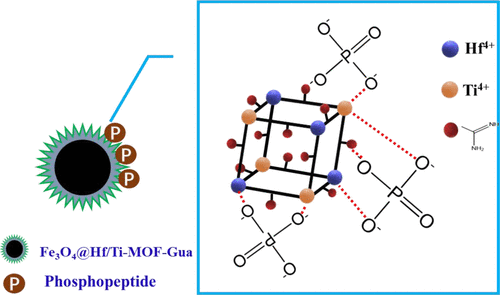当前位置:
X-MOL 学术
›
ACS Sustain. Chem. Eng.
›
论文详情
Our official English website, www.x-mol.net, welcomes your
feedback! (Note: you will need to create a separate account there.)
Guanidyl-Functionalized Magnetic Bimetallic MOF Nanocomposites Developed for Selective Enrichment of Phosphopeptides
ACS Sustainable Chemistry & Engineering ( IF 7.1 ) Pub Date : 2020-10-29 , DOI: 10.1021/acssuschemeng.0c04118 Jia-yuan Li 1 , Sen Zhang 1 , Wei Gao 1 , Yu Hua 1 , Hong-zhen Lian 1
ACS Sustainable Chemistry & Engineering ( IF 7.1 ) Pub Date : 2020-10-29 , DOI: 10.1021/acssuschemeng.0c04118 Jia-yuan Li 1 , Sen Zhang 1 , Wei Gao 1 , Yu Hua 1 , Hong-zhen Lian 1
Affiliation

|
In this work, guanidine group-modified magnetic hafnium and titanium bimetallic metal–organic framework (MOF) nanocomposites denoted as Fe3O4@Hf/Ti-MOF-Gua were developed by a solvothermal method and post-synthetic route. Through combining metal affinity chromatography with hydrophilic interaction, the as-prepared nanomaterial was used for identifying phosphopeptides from tryptic digests of α-/β-casein by matrix-assisted laser desorption ionization-time of flight mass spectrometry and showed high sensitivity (20 fmol), high selectivity for phosphopeptides from α-/β-casein tryptic digests/phosphoprotein α-casein/BSA (1:1:2000:2000), and great reusability of three circles for capturing phosphopeptides. Because of excellent enrichment performance with a high recovery of 85.4%, this affinity probe was subsequently applied to real samples, and 27 and 15 phosphopeptides were identified from nonfat milk and human saliva, respectively. The above remarkable advantages benefitted from the strong affinity of abundant Hf4+/Ti4+ on the large surface of the MOF shell with the improved hydrophilicity from a large number of guanidyl groups. Consequently, the novel Fe3O4@Hf/Ti-MOF-Gua nanocomposites not only efficiently captured phosphopeptides but also removed macromolecular proteins, indicating their great potential for the application in identification and further analysis of low-abundance phosphopeptides from complex biological samples.
中文翻译:

胍基官能化的磁性双金属MOF纳米复合材料开发用于选择性富集磷酸肽。
在这项工作中,胍基修饰的磁性ha和钛双金属金属-有机骨架(MOF)纳米复合材料表示为Fe 3 O 4@ Hf / Ti-MOF-Gua是通过溶剂热法和后合成途径开发的。通过将金属亲和色谱与亲水相互作用结合,所制备的纳米材料通过基质辅助激光解吸电离飞行时间质谱法从α-/β-酪蛋白的胰蛋白酶消化物中鉴定出磷酸肽,并显示出高灵敏度(20 fmol) ,对α-/β-酪蛋白胰蛋白酶消化物/磷酸蛋白α-酪蛋白/ BSA的磷酸肽具有很高的选择性(1:1:2000:2000),并且三个环具有很高的重用性,可用于捕获磷酸肽。由于出色的富集性能和85.4%的高回收率,该亲和探针随后应用于实际样品,分别从脱脂牛奶和人唾液中鉴定出27和15个磷酸肽。MOF壳大表面上的4+ / Ti 4+具有来自大量胍基的改善的亲水性。因此,新型的Fe 3 O 4 @ Hf / Ti-MOF-Gua纳米复合材料不仅可以有效地捕获磷酸肽,而且还可以去除大分子蛋白质,表明它们在鉴定和进一步分析复杂生物样品中的低丰度磷酸肽方面具有巨大的潜力。
更新日期:2020-11-09
中文翻译:

胍基官能化的磁性双金属MOF纳米复合材料开发用于选择性富集磷酸肽。
在这项工作中,胍基修饰的磁性ha和钛双金属金属-有机骨架(MOF)纳米复合材料表示为Fe 3 O 4@ Hf / Ti-MOF-Gua是通过溶剂热法和后合成途径开发的。通过将金属亲和色谱与亲水相互作用结合,所制备的纳米材料通过基质辅助激光解吸电离飞行时间质谱法从α-/β-酪蛋白的胰蛋白酶消化物中鉴定出磷酸肽,并显示出高灵敏度(20 fmol) ,对α-/β-酪蛋白胰蛋白酶消化物/磷酸蛋白α-酪蛋白/ BSA的磷酸肽具有很高的选择性(1:1:2000:2000),并且三个环具有很高的重用性,可用于捕获磷酸肽。由于出色的富集性能和85.4%的高回收率,该亲和探针随后应用于实际样品,分别从脱脂牛奶和人唾液中鉴定出27和15个磷酸肽。MOF壳大表面上的4+ / Ti 4+具有来自大量胍基的改善的亲水性。因此,新型的Fe 3 O 4 @ Hf / Ti-MOF-Gua纳米复合材料不仅可以有效地捕获磷酸肽,而且还可以去除大分子蛋白质,表明它们在鉴定和进一步分析复杂生物样品中的低丰度磷酸肽方面具有巨大的潜力。











































 京公网安备 11010802027423号
京公网安备 11010802027423号